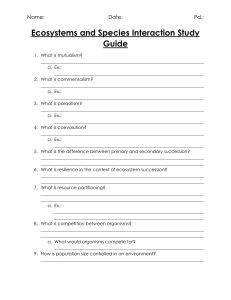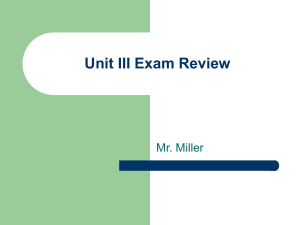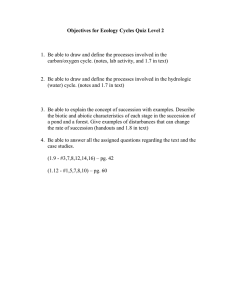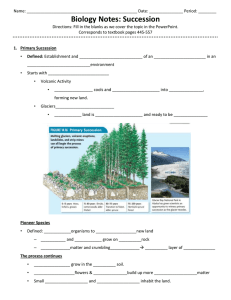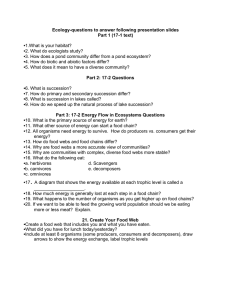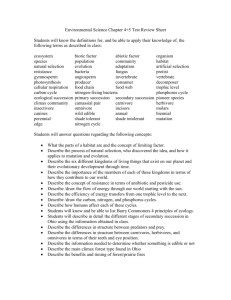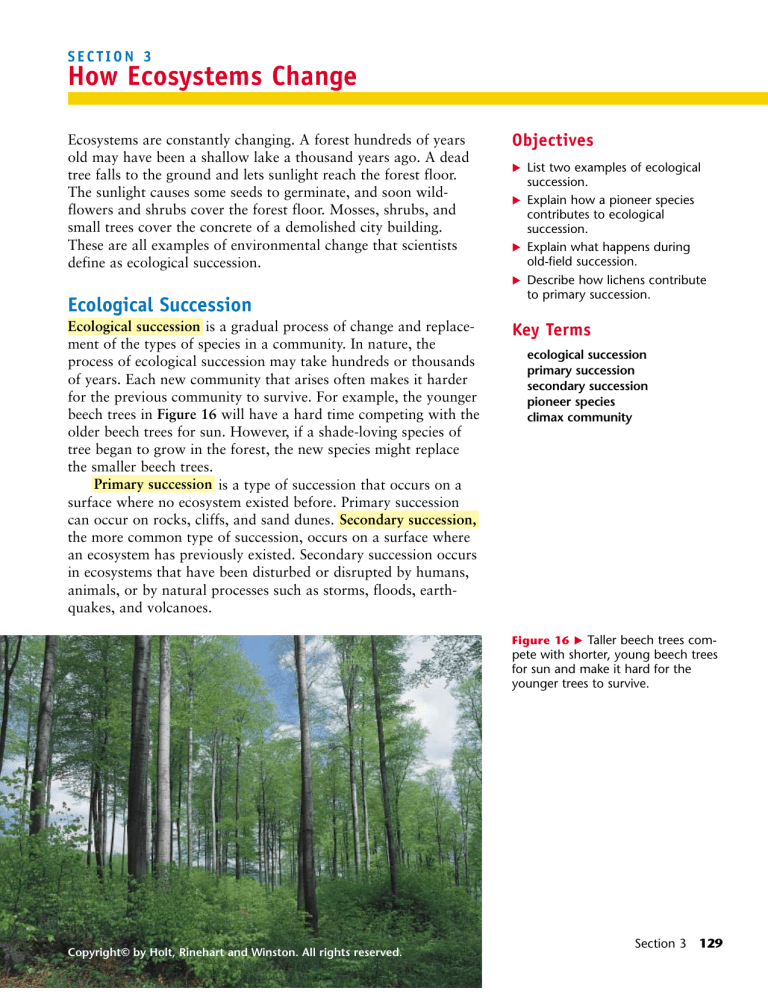
SECTION 3 How Ecosystems Change Ecosystems are constantly changing. A forest hundreds of years old may have been a shallow lake a thousand years ago. A dead tree falls to the ground and lets sunlight reach the forest floor. The sunlight causes some seeds to germinate, and soon wildflowers and shrubs cover the forest floor. Mosses, shrubs, and small trees cover the concrete of a demolished city building. These are all examples of environmental change that scientists define as ecological succession. Ecological Succession Ecological succession is a gradual process of change and replacement of the types of species in a community. In nature, the process of ecological succession may take hundreds or thousands of years. Each new community that arises often makes it harder for the previous community to survive. For example, the younger beech trees in Figure 16 will have a hard time competing with the older beech trees for sun. However, if a shade-loving species of tree began to grow in the forest, the new species might replace the smaller beech trees. Primary succession is a type of succession that occurs on a surface where no ecosystem existed before. Primary succession can occur on rocks, cliffs, and sand dunes. Secondary succession, the more common type of succession, occurs on a surface where an ecosystem has previously existed. Secondary succession occurs in ecosystems that have been disturbed or disrupted by humans, animals, or by natural processes such as storms, floods, earthquakes, and volcanoes. Objectives 왘 List two examples of ecological succession. 왘 Explain how a pioneer species contributes to ecological succession. 왘 Explain what happens during old-field succession. 왘 Describe how lichens contribute to primary succession. Key Terms ecological succession primary succession secondary succession pioneer species climax community Figure 16 왘 Taller beech trees com- pete with shorter, young beech trees for sun and make it hard for the younger trees to survive. Copyright© by Holt, Rinehart and Winston. All rights reserved. Section 3 129 Secondary Succession In 1980, the volcano Mount St. Helens erupted in Washington State. The eruption at Mount St. Helens has been described as one of the worst volcanic disasters because more than 44,460 acres of forest were burned and flattened by the force of hot ash and other volcanic debris, as shown in Figure 17. After the eruption, plants began to colonize the volcanic debris. Such plants are called pioneer species —the first organisms to colonize any newly available area and begin the process of ecological succession. Over time, pioneer species will make the new area habitable for other species. If you visited Mount St. Helens today, you would find that the forest is in the process of secondary succession. Figure 18 shows how after 12 years, plants and flowers had covered most of the lava and new trees and shrubs had started to grow. If these organisms at Mount St. Helens continue to grow, over time they will eventually form a climax community. A climax community is Figure 17 왘 When Mount St. Helens erupted in 1980, much of the forest around the volcano was destroyed. Communities Maintained by Fire Fires set by lightning or human activities occasionally sweep through large areas. Burned areas undergo secondary succession. In the forests of the Rocky Mountains, for example, burned areas are rapidly colonized by fireweed, which clothes the slopes with purple flowers. In some places, fire determines the nature of the climax community. In the United States, ecological communities that are maintained by fire include the chaparral of California, the temperate grassland of the Midwest, and many southern and western pine forests. Plants native to these communities are adapted to living with fire. A wildfire that is not unusually hot may not harm fire-adapted pine trees, but it can kill deciduous trees—those trees that lose their leaves in winter. Seeds of 왘 Fireweed is one type of plant that colonizes land after the land has been burned by fire. some species, such as longleaf pine trees, will not germinate until exposed to temperatures of several hundred degrees. When a fire sweeps through a forest, the fire kills plants on the ground and stimulates the pine seeds to germinate. 130 Chapter 5 How Ecosystems Work Longleaf pines have a strange growth pattern. When they are young, they have long needles that reach down to the ground, and the trees remain only approximately a half of a meter high for many years, while they store nutrients. If a fire occurs, it sweeps through the tops of the tall trees that survived the last fire and the young longleaf pines near the ground may escape the fire. Then, the young pines use their stored food to grow very rapidly. A young pine can grow as much as 2 m/y. Soon the young pines are tall enough so that a fire near the ground would not harm them. If regular fires are prevented in a fire-adapted community, deciduous trees may invade the area. These trees form a thick barrier near the ground. In addition, their dead leaves and Copyright© by Holt, Rinehart and Winston. All rights reserved. a final and stable community. Even though a climax community continues to change in small ways, this type of community may remain the same through time if it is not disturbed. Fire and Secondary Succession Natural fires caused by lightning are a necessary part of secondary succession in some communities, as discussed in the Case Study below. Some species of trees, such as the Jack pine, can release their seeds only after they have been exposed to the intense heat of a fire. Minor forest fires remove accumulations of brush and deadwood that would otherwise contribute to major fires that burn out of control. Some animal species also depend on occasional fires because they feed on the vegetation that sprouts after a fire has cleared the land. Therefore, foresters sometimes allow natural fires to burn unless the fires are a threat to human life or property. Figure 18 왘 The photo above was taken 12 years after the eruption of Mount St. Helens and shows evidence of secondary succession. 왘 This firefighter is helping maintain a controlled fire in 왘 These young lodgepole pine trees have started growing after a devastating forest fire. branches pile up on the ground and form extra fuel for fires. When a fire does occur, it is hotter and more severe than usual. The fire destroys not only the deciduous trees but also the pines. It may end up as a devastating wildfire. Although it may seem odd, frequent burning is essential to preserve many plant communities and the animals that depend on them. This is the reason the U.S. Park South Dakota. Some fires are set on purpose by fire officials to bring nutrients to soil from burned vegetation. Service adopted the policy of letting fires in national parks burn if they do not endanger human life or property. This policy caused a public outcry when fires burned Yellowstone National Park in 1988, because people did not understand the ecology of fire-adapted communities. The fires later became an opportunity for visitors to learn about the changes in an ecosystem after a fire. Copyright© by Holt, Rinehart and Winston. All rights reserved. CRITICAL THINKING 1. Understanding Processes Explain how a longleaf pine tree might be more likely to survive a forest fire than a deciduous tree, such as a maple or oak tree. 2. Understanding Concepts Why must controlled fires be set in some ecosystems? What are the advantages? What are the disadvantages? Section 3 How Ecosystems Change 131 Figure 19 왘 The illustration above shows what an abandoned farm area might look like during old-field succession. Why do you think young oak trees begin to appear around year 20? FIELD ACTIVITY Investigating Succession Explore two or three blocks in your neighborhood, and find evidence of succession. Make notes in your EcoLog about the location and the evidence of succession that you observe. Pay attention to sidewalks, curbs, streets, vacant lots, and buildings, as well as parks, gardens, fields, and other open areas. Create a map from your data that identifies where succession is taking place in your neighborhood. 132 Chapter 5 How Ecosystems Work Old-field Succession Another example of secondary succession is old-field succession, which occurs when farmland is abandoned. When a farmer stops cultivating a field, grasses and weeds quickly grow and cover the abandoned land. The pioneer grasses and weeds grow rapidly and produce many seeds to cover large areas. Then over time, taller plants, such as perennial grasses, grow in the area. These plants shade the ground, which keeps light from the shorter pioneer plants. The long roots of the taller plants also absorb most of the water in the soil and deprive the pioneer plants of adequate water to survive. The pioneer plants soon die from lack of sunlight and water. As succession continues, the taller plants are deprived of light and water by growing trees. Finally, slower-growing trees, such as oaks, hickories, beeches, and maples, take over the area and block out the sunlight to the smaller trees. As shown in Figure 19, after about a century, the land can return to the climax community that existed before the farmers cleared it to plant crops. Primary Succession On new islands created by volcanic eruptions, in areas exposed when a glacier retreats, or on any other surface that has not previously supported life, primary succession can occur. Primary succession is much slower than secondary succession because primary succession begins where there is no soil. It can take several hundred to several thousand years to produce fertile soil naturally. Imagine that a glacier melts and exposes an area of bare rock. The first pioneer species to colonize the bare rock will probably be bacteria and lichens, which can live without soil. Lichens, as shown in Figure 20, are important early pioneers in primary Copyright© by Holt, Rinehart and Winston. All rights reserved. succession. They are the colorful, flaky patches that you see on trees and rocks. A lichen is a producer that is actually composed of two different species, a fungus and an alga. The alga photosynthesizes, while the fungus absorbs nutrients from rocks and holds water. Together, they begin to break down the rock. As the growth of the lichen breaks down the rock, water may freeze and thaw in cracks, which breaks up the rock further. Soil slowly accumulates as dust particles in the air are trapped in cracks in the rock. Dead remains of lichens and bacteria also accumulate in the cracks. Mosses may later grow larger and break up the rock even more. When the mosses die, they decay and add material and nutrients to the growing pile of soil. Thus, fertile soil forms from the broken rock, decayed organisms, water, and air. Primary succession can also be seen in any city street as shown in Figure 20. Mosses, lichens, and weeds can establish themselves in cracks in a sidewalk or building. Fungi and mosses can also invade a roof that needs repair. Even New York City would eventually turn into a cementfilled woodland if it were not constantly cleaned and maintained. SECTION 3 www.scilinks.org Topic: Ecological Succession SciLinks code: HE4024 Figure 20 왘 Lichens (left) are colo- nizing a boulder in Wyoming. Over a long period of time, lichens can break down rock into soil. Plants that grow through cracks in city sidewalks (below) can also be described as pioneers of primary succession. Review 1. Compare primary and secondary succession. CRITICAL THINKING 2. Describe what role a pioneer species plays during the process of ecological succession. 5. Analyzing Processes Over a period of 1,000 years, a lake becomes a maple forest. Is this process primary or secondary succession? Explain your answer. 3. Explain why putting out forest fires may be damaging in the long run. 4. Describe the role lichens play in primary succession. Write a short paragraph to explain your answer. WRITING SKILLS Copyright© by Holt, Rinehart and Winston. All rights reserved. 6. Analyzing Relationships How are lichens similar to the pioneer species that colonize abandoned farm areas? How are they different? Section 3 How Ecosystems Change 133 CHAPTER 5 Highlights Key Terms Main Ideas photosynthesis, 117 producer, 118 consumer, 118 decomposer, 119 cellular respiration, 120 food chain, 122 food web, 122 trophic level, 122 왘 The majority of the Earth’s organisms depend on the sun for energy. Producers harness the sun’s energy directly through photosynthesis, while consumers use the sun’s energy indirectly by eating producers or other consumers. 왘 The paths of energy transfer can be followed through food chains, food webs, and trophic levels. 왘 Only about 10 percent of the energy that an organism consumes is stored and transferred when that organism is eaten. 2 The Cycling of Materials carbon cycle, 124 nitrogen-fixing bacteria, 126 nitrogen cycle, 126 phosphorus cycle, 127 왘 Materials in ecosystems are recycled and reused by natural processes. 왘 Carbon, nitrogen, and phosphorus are essential for life, and each of them follows a recognizable cycle. 왘 Humans can affect the cycling of materials in an ecosystem through activities such as burning fossil fuels and applying fertilizer to soil. 3 How Ecosystems Change ecological succession, 129 primary succession, 129 secondary succession, 129 pioneer species, 130 climax community, 130 왘 Organisms in an environment sometimes follow a pattern of change over time known as ecological succession. 왘 Secondary succession occurs on a surface where an ecosystem has previously existed. Primary succession occurs on a surface where no ecosystem existed before. 왘 Climax communities are made up of organisms that take over an ecosystem and remain until the ecosystem is disturbed again. 1 Energy Flow in Ecosystems 134 Chapter 5 Highlights Copyright© by Holt, Rinehart and Winston. All rights reserved. CHAPTER Using Key Terms 5 Review Use each of the following terms in a separate sentence. 1. photosynthesis 2. trophic level 3. carbon cycle 4. nitrogen-fixing bacteria 5. decomposers For each pair of terms, explain how the meanings of the terms differ. 6. producer and consumer 7. primary succession and secondary succession 8. nitrogen cycle and phosphorus cycle 9. food chain and food web 13. 14. 15. STUDY TIP Taking Multiple-Choice Tests When you take multiple-choice tests, be sure to read all of the choices before you pick the correct answer. Be patient, and eliminate choices that are obviously incorrect. 16. Understanding Key Ideas 10. Which of the following statements is not true of consumers? a. They get energy indirectly from the sun. b. They are also called heterotrophs. c. They make their own food. d. They sometimes eat other consumers. 11. Which of the following is correctly arranged from the lowest trophic level to the highest trophic level? a. bacteria, frog, eagle, mushroom b. algae, deer, wolf, hawk c. grass, mouse, snake, eagle d. grass, bass, minnow, snake 12. Communities of bacteria have been found living thousands of feet underwater. Which of the following statements is a proper conclusion to draw about these bacteria? a. Somehow they are conducting photosynthesis. b. They are living on borrowed time. Copyright© by Holt, Rinehart and Winston. All rights reserved. 17. 18. c. They were somehow introduced by human activities. d. They use an energy source other than sunlight. Which of the following pairs of organisms probably belong to the same trophic level? a. humans and bears b. bears and deer c. humans and cows d. both (a) and (c) The energy lost between trophic levels a. can be captured only by parasitic organisms. b. cools the surrounding environment. c. is used in the course of normal living. d. evaporates in the atmosphere. From producer to secondary consumer, about what percentage of energy is lost? a. 10 percent b. 90 percent c. 99 percent d. 100 percent Which of the following statements about the nitrogen cycle is not true? a. Animals get nitrogen by eating plants or other animals. b. Plants generate nitrogen in their roots. c. Nitrogen moves back and forth between the atmosphere and living things. d. Decomposers break down waste to yield ammonia. Which of the following are most likely to be the pioneer organisms on an area of bare rock? a. saplings b. shrubs c. lichens d. perennial grasses Excessive use of fertilizer that contains nitrogen and phosphorus a. affects the carbon cycle. b. may cause algal blooms in waterways. c. causes soil erosion. d. contributes to primary succession. Chapter 5 Review 135 CHAPTER Short Answer 5 Review 19. Explain the relationship between cellular respiration and photosynthesis. 20. Why is the number of trophic levels that can exist limited? 21. Why are decomposers an essential part of an ecosystem? 22. Write a short paragraph that explains why the phosphorus cycle occurs slower than the carbon and nitrogen cycles. WRITING SKILLS 23. Describe the role of carbon dioxide in the carbon cycle. Interpreting Graphics Use the diagram to answer questions 24–26. 24. How many organisms depend on the squid as a source of food? 25. If the population of Adélie penguins decreased drastically in this ecosystem, what effect would the decreased number of penguins have on elephant seals? 26. What role do algae play in this food web? Concept Mapping ? ? ? 27. Use the following terms to create a concept map: algae, humans, solar energy, carnivores, consumers, producers, directly, herbivores, indirectly, and omnivores. Critical Thinking 28. Comparing Processes How are producers and decomposers opposites of each other? 29. Inferring Relationships Abandoned fields in the southwestern part of the United States are often taken over by mesquite trees, which can grow in nutrient-poor soil. If the land is later cleared of mesquite, the soil is often found to be enriched with nitrogen and is more suitable for crops. What might be the reason for this phenomenon? 30. Understanding Concepts Read the description under the head, “What Eats What” in this chapter, and explain why decomposers are considered to be consumers. READING SKILLS 31. Drawing Conclusions Suppose that a plague eliminates all the primary consumers in an ecosystem. What will most likely happen to organisms in other trophic levels in this ecosystem? Cross-Disciplinary Connection 32. Mathematics If a lake contains 600,000 kg of plankton and the top consumers are a population of 40 pike, which each weigh an average of 15 kg, how many trophic levels does the lake contain? Make a graph or pyramid that illustrates the trophic levels. Portfolio Project 33. Research Local Succession Do a special project on succession. Find areas in your community that have been cleared of vegetation and left unattended at different times in the past. Ideally, you should find several areas that were cleared at different times, including recently and decades ago. Photograph each area, and arrange the pictures to show how succession takes place in your geographic region. 136 Chapter 5 Review Copyright© by Holt, Rinehart and Winston. All rights reserved. MATH SKILLS Use the data in the table below to answer questions 34–35. Percentage of Fertilizer Use per Year Region of the World Percentage North America 17 Asia 52 Africa 3 Europe 18 Latin America and the Caribbean 8 Oceania 2 34. Making Calculations If 137.25 million metric tons of fertilizer is used worldwide per year, how many million metric tons does Asia use? 35. Graphing Data Make a bar graph that compares the percentage of fertilizer use in different regions worldwide per year. WRITING SKILLS 36. Communicating Main Ideas Describe the importance of the carbon, nitrogen, and phosphorus cycles to humans. 37. Writing from Research Research information on how countries regulate carbon dioxide emissions. Write an essay that describes the laws regulating carbon dioxide emissions and the solutions some countries have devised to decrease the amount of carbon dioxide emitted. READING FOLLOW-UP Now that you have read the chapter, take a moment to review your answers to the Reading Warm-Up questions in your EcoLog. If necessary, revise your answers. Copyright© by Holt, Rinehart and Winston. All rights reserved. Read the passage below, and then answer the questions that follow. The Peruvian economy and many sea birds depend on normal atmospheric conditions. But sometimes, usually in December, the normal east-to-west winds do not form over the Pacific Ocean. Instead, winds push warm water eastward toward the coast of South America. When these conditions occur, the warm surface water cuts off the upwelling of nutrients. This event is called El Niño, which means “the child,” because it happens near Christmas. Because all convection cells are linked in the atmosphere, the effects of El Niño extend beyond Peru. Under a strong El Niño, northeastern Australia can suffer summer drought, which leads to reduced grain production there. The southeastern United States gets higher rainfall in El Niño years, which boosts agriculture and decreases forest fires. 1. According to the passage, a possible cause of reduced grain production in Australia is a. a rate of convection that is higher than the average rate. b. an amount of rainfall that is higher than the average amount. c. a reduced fish population. d. a summer drought. 2. According to the passage, which of the following statements is true? a. The effects of El Niño do not extend beyond Peru. b. During El Niño years, the U.S. agricultural industry suffers. c. El Niño is caused by winds that push warm water eastward toward South America. d. Australia’s agricultural industry benefits the most from strong winds during El Niño. Chapter 5 Review 137 CHAPTER Objectives 5 왘 Examine the remains of an owl’s diet. 왘 USING SCIENTIFIC METHODS Construct a food chain based on your observations. Materials disposable gloves dissecting needle dissecting pan egg cartons forceps owl pellet(s) piece of white paper small animal identification field guide that includes skull illustrations Exploration Lab: OBSERVATION Dissecting Owl Pellets Owls are not known as finicky eaters. They prey on almost any animal that they can swallow whole. Like many other birds, owls have an interesting adaptation—a special structure called a gizzard. The gizzard acts as a filter and prevents the indigestible parts of their prey, such as fur, feathers, and bones—from passing into their intestines. These indigestible parts are passed to a storage pouch, where they accumulate. A few hours after consuming a meal, the owl coughs up the accumulated indigestible material, which has been compressed into a pellet. By examining such a pellet, you can tell what the owl ate. In addition, by examining the remains of the owl’s prey found in the pellet, you can get a good idea of what the prey ate. Using this information, you can construct a food chain of the owl and its prey. Procedure 1. Work in groups of three or four. Place an owl pellet in the dissecting pan, and remove it from its aluminum-foil casing. 2. Examine the owl pellet. Using the dissecting needle and forceps, carefully break apart the owl pellet. Separate the fur or feathers from the bones. Be careful not to damage the small bones. Place the bones onto a piece of white paper. 3. Identify the major components of the pellet. 4. If the pellet contains remains from more than one organism, determine as best as you can how many different animals and species are present. 5. Attempt to group the remains by type of organism. Count the number of skulls to find out how many prey were in the pellet. Decide which bones belong with which skulls. Then try to assemble complete skeletons. Sample skeletal diagrams are shown below. 왘 Types of Organisms Use these drawings to help you determine if the organism you put together is a bird, mammal, or reptile. 138 Chapter 5 Exploration Lab Copyright© by Holt, Rinehart and Winston. All rights reserved. 6. Closely examine the skulls of each prey. Compare the skulls to the diagrams of skulls on this page. What purpose do the teeth or bills seem to have—tearing flesh, chewing plant parts, or grinding seeds? If you are able to identify the prey, find out their typical food sources. 7. On a separate piece of paper, construct a simple food chain based on your findings. 8. Compare your findings with those of other groups of students. 왘 Identify the Prey Use these drawings to identify the owl’s prey. Analysis 1. Examining Data How many skeletons were you able to make from your pellet? What kinds of animals did you identify in the owl pellet? 2. Organizing Data Compare your findings with those of your classmates by using the following questions: a. What animals were represented most often in the pellets? b. What common traits do these animals have? c. How many animals found in the pellets were herbivores? How many were carnivores? Conclusions 3. Interpreting Information What biological relationships were you able to determine from your examination of the owl pellets? 4. Evaluating Data Of the animals you found in your pellet, how many different trophic levels are represented? 5. Drawing Conclusions Most owls hunt at night and sleep during the day. From that information, what can you infer about their prey? Extension 1. Research and Communications Research information on an owl species and the types of organisms found in its habitat. Make a poster of a food web, including the owl species. Be sure to include producers, consumers, and decomposers. Copyright© by Holt, Rinehart and Winston. All rights reserved. Chapter 5 Exploration Lab 139 DOPPLER RADAR TRACKING OF BATS AND INSECTS IN CENTRAL TEXAS 왘 These images of bat and insect concentration in Central Texas were created using Doppler radar on the evening of May 19, 2002. Doppler radar can track the movement of objects in the air by bouncing electromagnetic energy off of them. MAP SKILLS Use the Doppler radar images of bats and insects in Central Texas to answer the questions below. 1. Analyzing Data At what time was the bat and insect concentration the lowest? At what time was the bat and insect concentration the highest? 2. Using a Key Use the concentration key to determine which area of Central Texas has the highest concentration of bats and insects at 8:14 P.M. 3. Analyzing Data Approximately how many kilometers wide is the concentration of bats and insects at 7:27 P.M.? at 8:14 P.M.? 140 Chapter 5 Maps in Action 4. Inferring Relationships Bracken Cave is home to 20 million bats that eat millions of pounds of insects nightly. Approximately how far is Bracken Cave from the city of San Antonio? If the bat population in the cave drastically decreased, what effect would this decrease have on the people living in San Antonio and Central Texas? 5. Identifying Trends These Doppler radar images of bats and insects were taken in the beginning of the summer season. How might these four images look in the month of December? Copyright© by Holt, Rinehart and Winston. All rights reserved. EATING THE BAIT Most of the food we eat comes from agriculture and farming, but we also rely heavily on the fishing industry to provide us with fresh fish. Because of a high demand for fish, however, many fish species have become overharvested. Many organisms depend on these fisheries, places where fish are caught, to survive. The swordfish and cod fisheries of the North Atlantic and the salmon fishery off the northwestern coast of the United States are examples of fisheries that have become depleted. These fisheries now contain so few fish that harvesting these fish is not economical. 왘 Overfishing of organisms from higher trophic levels has forced the commercial fishing industry to harvest organisms in lower trophic levels in order to fulfill the demand for fresh fish. Fishing Down the Food Chain Fish such as cod, tuna, and snapper are top carnivores in ocean food chains and food webs. As these fish have disappeared, species from lower trophic levels have begun to appear in fish markets. Fish that were once swept back into the sea when they were caught in nets by accident are now being kept and sold. Organisms from lower trophic levels such as mullet, squid, mackerel, and herring, which were typically used as bait to catch larger fish, now appear on restaurant menus. According to data from the United Nations on worldwide fish harvests, the overall trophic level at which most fish are caught has declined since the 1950s. Overfishing of organisms in lower trophic levels disrupts food chains and food webs. If the food webs of ocean ecosystems collapse, the commercial fishing industry will also collapse. For example, in the North Atlantic cod fisheries, the cod began to disappear, so the fishermen concentrated on the cods’ prey, which is shrimp. Cod are higher trophic level organisms, while shrimp are in the lower trophic levels and feed on algae and detritus. If the shrimp and the cod become overfished, the other organisms that depend on both the shrimp and cod to survive are affected. Creating Sustainable Fisheries One aim of environmental science is to determine how fisheries can be managed so that they are sustainable or capable of supplying the same number of fish to be harvested each year. However, few, if any, countries manage their Copyright© by Holt, Rinehart and Winston. All rights reserved. 왘 A squid is an example of an organism from a lower trophic level that was used for bait but is now sold in restaurants. fisheries in this way. Almost all countries permit unsustainable, large harvests. One solution to overfishing is to establish “notake” zones. These are areas of the sea where no fishing is permitted. Studies have shown that fish populations grow rapidly in “notake” zones. When a population grows in a “no-take zone,” the higher trophic level organisms leave the zone and become available to fishermen. “No-take” zones help populations recover and allow food chains and food webs to remain intact. What Do You Think? The next time you go to a fish market or seafood restaurant, take note of the different types of species for sale. Write down the names of the species, and try to assign each species to a trophic level. How many of the species for sale belong to lower trophic levels? How many belong to higher trophic levels? How do prices differ between the species for sale? Chapter 5 Society and the Environment 141
